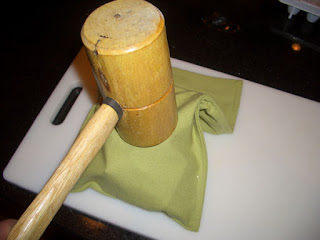3/4 tsp Sugar (Turbinado Sugar)
3-4 dash (1/2 oz) Lemon Juice
2-3 dash (1/4 oz) Lime Juice
1 Egg White
1 wineglass (2 oz) Scotch Whiskey (Caol Ila 12 Yr)
3-4 dash (1/2 tsp) Absinthe (Versinthe La Blanche)
Soda Water (to fill, ~1 oz)
Shake sugar, juices, and egg whites without ice to solubilize the sugar and break up the egg white. Add Scotch, absinthe, and ice; shake and strain into a cocktail glass or highball glass. Top with soda water.

Last night as we were making pizza, it was time for cocktails. I picked out two drinks for the night -- one egg white and one egg yolk to best utilize the whole egg and reduce waste. The egg white drink was one I picked off of the Anvil bar's '
100 drinks that everyone should try at least once' list. This drink was the Morning Glory Fizz which dropped the remainder to 17 drinks left to try. The list has it as a "Morning Glory" and in trying to match up the proper drink (the list does not give a recipe source) with the bounty of other Morning Glory recipes out there, we found one in David Wondrich's
Imbibe! which seemed the oldest and closest to the "scotch, lemon, egg white, absinthe" ingredients (*). The Morning Glory Fizz added to the equation sugar, lime juice, and soda water but seemed a decent enough of a match. Wondrich found the recipe in Harry Johnson's 1882 book
New and Improved Bartender's Manual, and he described it as an early and successful attempt at mixing with Scotch. He also surmised that it may be a Harry Johnson original recipe. The conversions from dashes to specific measurements listed above were Wondrich's suggestions.
The Morning Glory Fizz was incredibly Scotchy in the nose and taste. Flavor-wise, after the peaty goodness, the lemon was on the forefront of the sip and lime on the swallow. The absinthe was rather subtle and became slightly more notable as the drink warmed up. The diminished absinthe signature might be due to the "3-4 dash" interpretation or our choice of absinthe. The Versinthe La Blanche absinthe might have been too meek to stand up to the mighty slug of Caol Ila Scotch in addition to the flavor smoothing effects of egg white. Indeed, our single malt selection was rather intense and perhaps the flavor profile would be more balanced with a blended Scotch like Famous Grouse. Or perhaps we just need to go shopping for more absinthes in the near future (**)...
(*) A web search just now brought up this
post by Paul Clarke in his Cocktail Chronicles blog. The post proffers an 1895 recipe from George Kappeler's
Modern American Drinks that matches the Anvil's ingredients list better than Johnson's. His post also provides a good perspective on the drink including an alternative recipe from Charles H. Baker's
The Gentleman’s Companion. Apparently, I should have saved the quaffing of this drink for 8 am instead of pm...
(**) Often we use one of our many pastises which are similar to absinthe save for the elevated alcohol content, wormwood, and price. La Muse Verte a/k/a Le Pastis d'Autrefois is one fine example which is dry, louche-able, and flavored akin to many absinthes, yet costs less than half as much (but only weighs in at 80 proof).





 1/3 Juice of a Grapefruit (2 oz)
1/3 Juice of a Grapefruit (2 oz)


 2 oz Plymouth Gin
2 oz Plymouth Gin The theme for this month’s
The theme for this month’s 












 1 oz Square One Botanicals
1 oz Square One Botanicals





 The 2017 collection of 855 drink recipes, bartender tributes, and essays on hospitality from CocktailVirgin's Frederic Yarm. Available at
The 2017 collection of 855 drink recipes, bartender tributes, and essays on hospitality from CocktailVirgin's Frederic Yarm. Available at  The 2012 collection of 505 drink recipes, techniques, and Boston bar recommendations from Frederic Yarm. Available at
The 2012 collection of 505 drink recipes, techniques, and Boston bar recommendations from Frederic Yarm. Available at 




